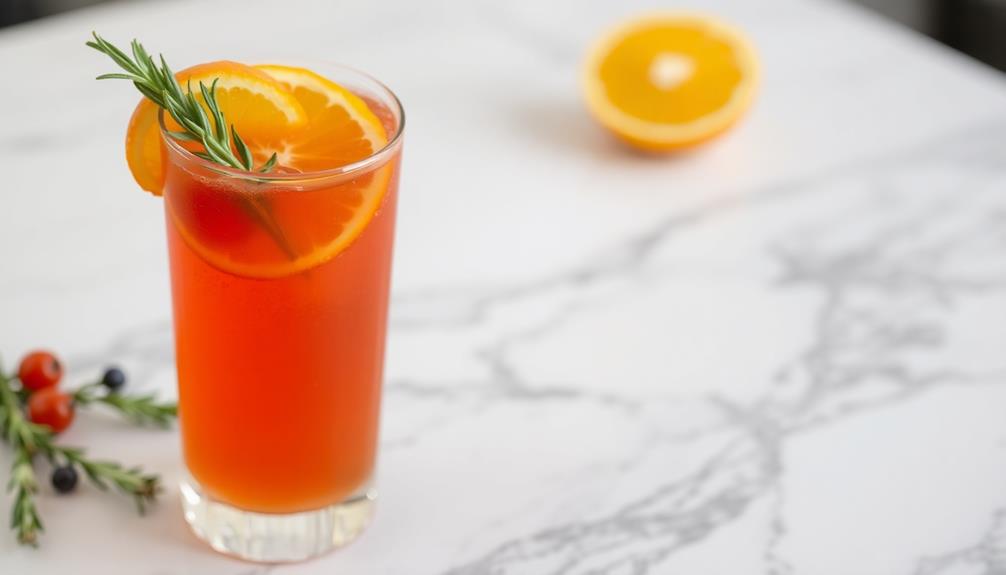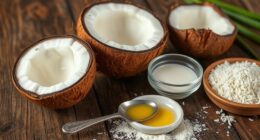Get ready to whip up your own bubbly, tangy, and health-boosting elixir right at home! Kombucha, that fermented tea marvel, has been revered for centuries as an "Immortal Health Drink." With just a few simple ingredients – like tea, sugar, and a special culture called a SCOBY – you can create your very own probiotic powerhouse. The brewing process is easy, though it does take some patience as the tea ferments over 1-2 weeks. But the payoff is a refreshing, customizable beverage full of beneficial bacteria. So gather your supplies and get ready to dive into the rich history and modern benefits of homemade kombucha!
Key Takeaways
- Obtain a SCOBY, which is essential for fermenting the sweet tea solution to create kombucha.
- Prepare a sweet tea solution by boiling water, steeping tea bags, and dissolving sugar, then allowing it to cool.
- Add the SCOBY and starter liquid to the sweet tea, cover, and let it ferment for 7-14 days to develop the desired tartness.
- Bottle the fermented kombucha, leaving headspace for carbonation, and optionally add sugar or fruit juice for enhanced fizziness.
- Experiment with various fruit juices, herbs, and spices to create unique flavor profiles and explore the health benefits of homemade kombucha.
History
The origins of kombucha can be traced back thousands of years, with early records of its consumption dating as far back as 221 BC in ancient China. Back then, this fizzy, fermented tea was revered for its purported health benefits and was even called the "Immortal Health Elixir."
Over the centuries, the recipe and preparation of kombucha spread to other parts of the world, including Russia, Japan, and Eastern Europe.
Today, kombucha has become a popular health drink, enjoyed for its tangy, slightly sweet flavor and its potential to support gut health.
As you brew your own kombucha at home, you're continuing a tradition that has spanned millennia. With each sip, you're connecting to the rich history of this unique and fascinating beverage.
Who knows – maybe your homemade kombucha will even grant you a touch of immortality!
Recipe
Kombucha is a fermented tea that has been enjoyed for centuries for its potential health benefits and unique flavor profile. Brewing kombucha at home allows you to customize the taste and control the ingredients. This recipe will guide you through the process of creating your own delicious kombucha at home.
Kombucha is made by fermenting sweetened black or green tea with a symbiotic culture of bacteria and yeast, commonly referred to as a SCOBY. The fermentation process transforms the sugary tea into a slightly effervescent, slightly tart beverage that can be further flavored to suit your preferences.
- 4 cups filtered water
- 4 tea bags (black or green tea)
- 1/2 cup white sugar
- 1 SCOBY (Symbiotic Culture of Bacteria and Yeast)
- 1/2 cup unflavored kombucha (from a previous batch or store-bought)
To brew the kombucha, bring the water to a boil, then remove from heat and steep the tea bags for 5-7 minutes. Discard the tea bags and stir in the sugar until it has completely dissolved.
Allow the sweetened tea to cool to room temperature. Once cooled, pour the tea into a clean, non-reactive container (such as a glass jar) and add the SCOBY and unflavored kombucha. Cover the container with a coffee filter or breathable cloth and secure it with a rubber band.
Allow the mixture to ferment at room temperature for 7-14 days, tasting it periodically to achieve your desired flavor and level of carbonation. As the fermentation progresses, you’ll notice the flavor becoming more complex, while the carbonation intensifies during the later stages. Make adjustments as needed by shortening or extending the fermentation period, depending on your preferences. Similar to tempeh fermentation methods, maintaining a consistent environment throughout the process will significantly affect the final result.
When the kombucha has reached your preferred taste, remove the SCOBY and reserve it for your next batch. You can then bottle the kombucha and let it sit at room temperature for an additional 1-3 days to further develop the carbonation.
Refrigerate the bottled kombucha and enjoy your homemade creation! Be sure to keep the SCOBY well-fed and stored in a small amount of kombucha to maintain its healthy condition for future batches.
Cooking Steps
Alright, let's get started on that homemade kombucha!
First, you'll need to obtain a SCOBY, a.k.a. the "mother" culture that helps ferment the tea.
Next, prepare a sweet tea solution and add your culture, then let it ferment for a bit.
Step 1. Obtain a SCOBY
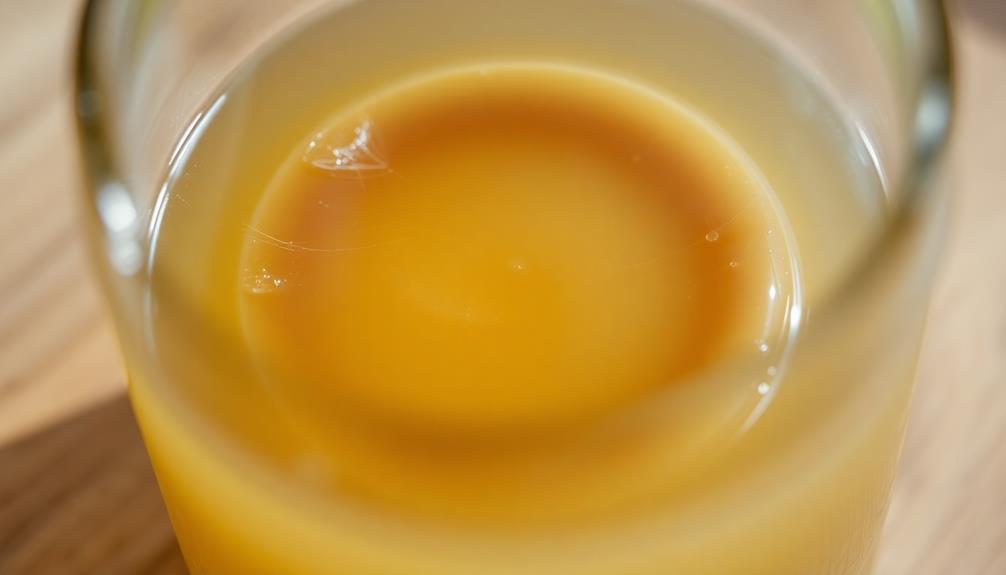
Acquiring a symbiotic culture of bacteria and yeast, or SCOBY, is the fundamental first step in your kombucha brewing journey. This amazing living organism is the heart and soul of your bubbly, tart, and healthy beverage.
Don't worry, you can easily get your hands on one! You can find SCOBYs online, at local brewing supply stores, or even ask friends who brew kombucha if they can share a slice of theirs.
When you receive your SCOBY, it will look like a thick, gelatinous pancake – don't be alarmed, that's perfectly normal! Gently place it in the vessel you'll be using for fermentation, along with the starter tea that came with it. This liquid contains all the essential bacteria and yeast your SCOBY needs to thrive.
With your SCOBY safely tucked in, you're well on your way to crafting delicious homemade kombucha. Just follow the remaining steps, and you'll be sipping your own fizzy creation in no time!
Step 2. Prepare Sweet Tea Solution
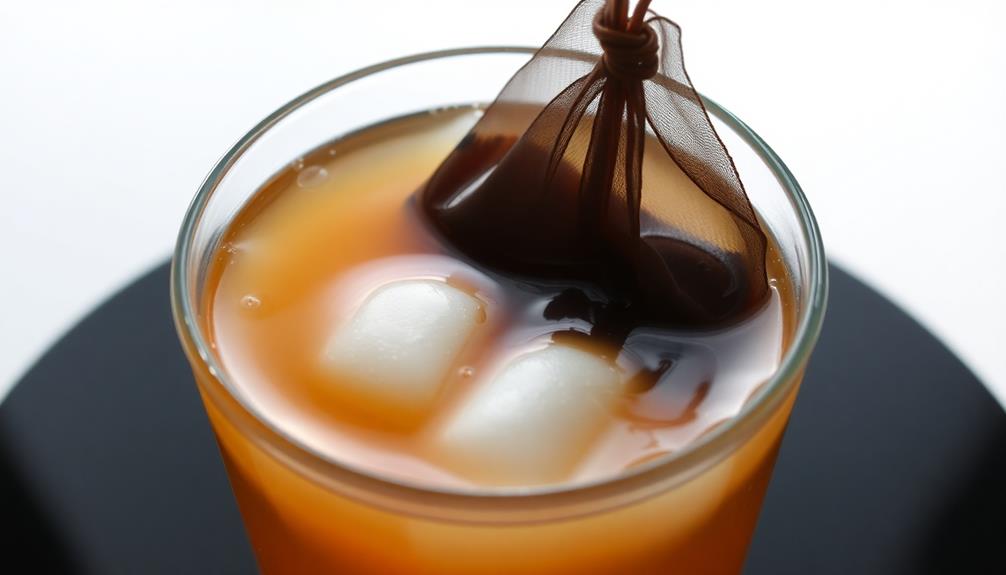
Brewing the perfect kombucha starts with crafting a sweet tea solution. First, gather your ingredients – black tea, sugar, and fresh, clean water.
Bring the water to a rolling boil in a large pot. Then, remove the pot from the heat and add the tea bags or loose-leaf tea. Let the tea steep for about 5-7 minutes, allowing the robust flavors to infuse the water.
Next, stir in the sugar until it completely dissolves. The ratio is typically 1 cup of sugar per 1 gallon of water. Make sure to use white, granulated sugar for best results.
Allow the sweet tea to cool completely before moving on to the next step. You want the temperature to be around room level, about 70-80°F.
Once the sweet tea is ready, it's time to pour it into your fermentation vessel. This could be a glass jar, mason jar, or even a large ceramic crock.
Be gentle when adding the SCOBY and starter liquid to avoid disrupting the delicate culture.
Step 3. Add Culture and Ferment
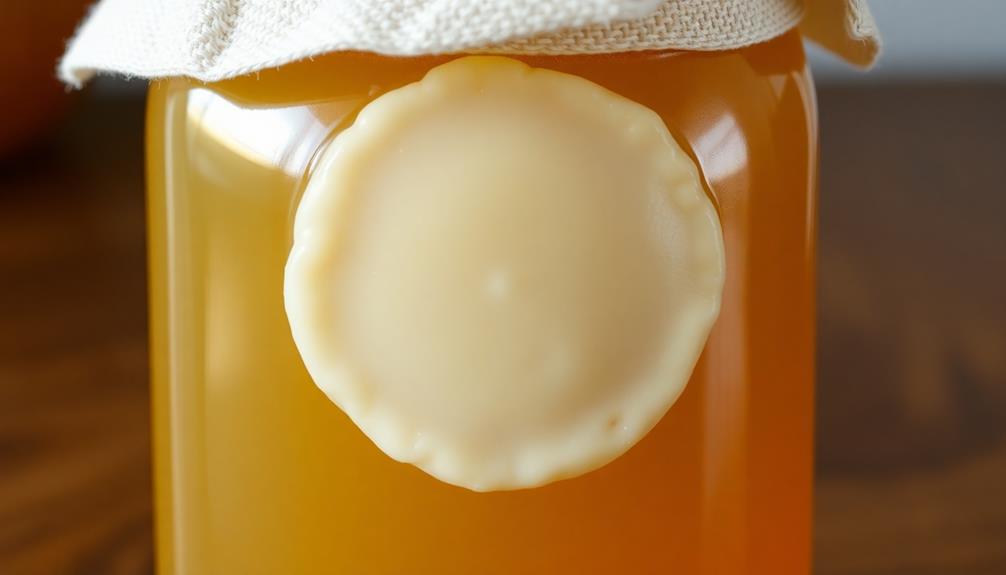
Once you've poured the cooled sweet tea into your fermentation vessel, it's time to add the SCOBY (Symbiotic Culture of Bacteria and Yeast) and starter liquid. This is the fun part! Gently place the SCOBY on top of the tea and pour in the starter liquid.
The SCOBY looks a bit like a flat, rubbery mushroom cap, and it's the heart of your kombucha operation. It will float on the surface and begin to work its magic, converting the sugars in the tea into tangy, fizzy kombucha. Using high-quality ingredients is essential, as it can enhance the flavor and health benefits of your brew, similar to the way herbal teas provide unique flavors.
Now, cover the vessel with a breathable cloth and secure it with a rubber band or string. This allows air to circulate but keeps out dust and insects.
Place your covered vessel in a warm, dark spot and let the fermentation begin. Over the next 7-14 days, the SCOBY will grow and the kombucha will develop its signature tartness. Keep an eye on it, and when it's ready, you can bottle it up and enjoy your very own homemade kombucha!
Step 4. Bottle and Carbonate the Kombucha
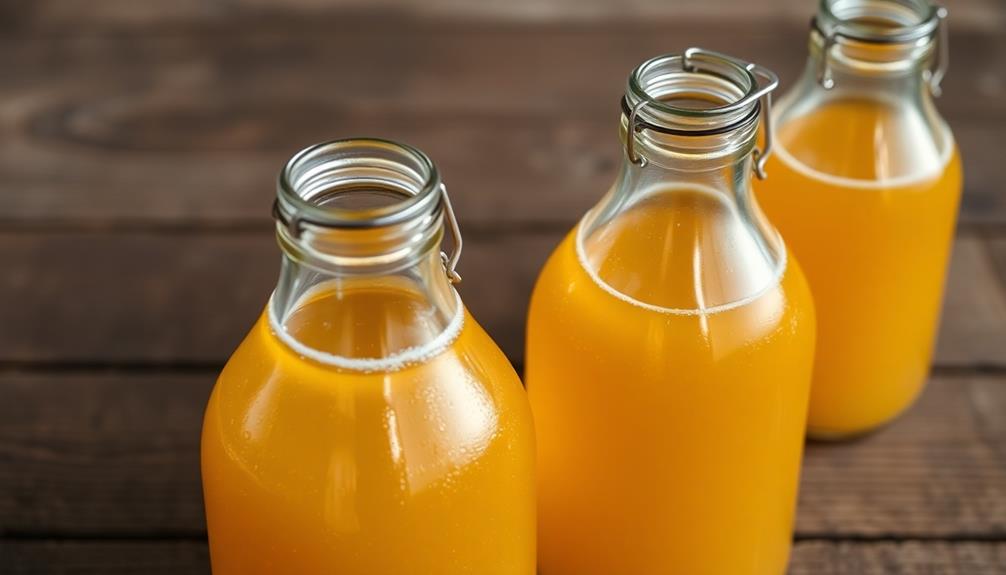
After the fermentation period, it's time to bottle and carbonate your kombucha! This is where the magic really happens. Get ready to watch your brew fizz and bubble to life.
First, use a funnel to carefully pour the fermented kombucha into clean bottles, leaving about an inch of headspace at the top. To enhance the flavor and health benefits, consider using different sugars that can influence fermentation speed.
Now, add a touch of sugar or fruit juice to each bottle – this will kickstart the carbonation process. Tightly seal the bottles and let them sit at room temperature for 2-4 days. You'll know it's ready when the bottles feel nice and firm.
Be careful when opening, as the kombucha will be bubbly and carbonated! Once it's carbonated to your liking, pop those bottles in the fridge to stop the fermentation.
Congratulations, you've brewed your very own batch of delicious, fizzy kombucha! Sip and enjoy the tangy, effervescent goodness. Yum!
Step 5. Enjoy Your Homemade Kombucha!

With your kombucha now carbonated and chilled, it's time to savor the fruits of your labor! Grab a tall glass and pour in the bubbly, amber-colored liquid. Isn't it just gorgeous?
Take a big whiff – can you smell the tangy, slightly sweet aroma? That's the magic of fermentation at work. Now, take a sip and let the refreshing flavors dance on your tongue. Feel how the carbonation tickles your taste buds. Isn't it so satisfying?
As you enjoy your homemade kombucha, consider adding a slice of lemon or a few berries to enhance the flavor. You can also experiment with different fruit juices or herbs to create unique taste combinations. The possibilities are endless!
Sit back, relax, and feel proud of yourself for brewing up this delicious, probiotic-rich beverage. With each sip, you're nourishing your body and treating your taste buds. Cheers to your homemade kombucha success!
Final Thoughts
Brewing kombucha at home can be a rewarding and cost-effective endeavor. Imagine the satisfaction of sipping your very own homemade fizzy, tangy tea – a refreshing and healthy alternative to sugary sodas.
As you've learned, the process is quite simple, and with a little practice, you'll be brewing batches like a pro.
Don't be afraid to experiment with different flavors and ingredients. Try adding fresh fruit, herbs, or spices to customize your kombucha to your taste buds. The possibilities are endless!
Remember, the keys to success are patience and attention to detail. Keep a close eye on your SCOBY, maintain a clean brewing environment, and adjust the fermentation time as needed.
Soon, you'll be impressing your friends and family with your homemade kombucha skills.
Frequently Asked Questions
How Long Does Kombucha Take to Ferment at Home?
Typically, homemade kombucha fermentation takes between 7-14 days. The exact time can vary depending on factors like temperature, sugar content, and your personal preference for taste. Be patient and taste it regularly to achieve your desired flavor profile.
Can I Use Green Tea Instead of Black Tea?
You absolutely can use green tea instead of black tea to brew kombucha at home. The fermentation process will work just the same, though the flavor profile may be a bit different. Experiment and see what you like best!
What Are the Benefits of Drinking Homemade Kombucha?
Drinking homemade kombucha can provide you with probiotics, antioxidants, and potential health benefits like improved digestion and immune function. The fermentation process also results in a unique, slightly fizzy taste you can customize to your liking.
How Do I Store My Kombucha After Brewing?
After brewing, you can store your kombucha in the refrigerator. This will slow down the fermentation process and keep your drink fresh. Be sure to use airtight containers to prevent carbonation loss and maintain the optimal flavor.
Can I Flavor My Kombucha With Different Fruits or Herbs?
You can absolutely flavor your kombucha with different fruits or herbs! Get creative and experiment with flavors like raspberry, ginger, or mint. Just be sure to follow proper carbonation and storage techniques for your kombucha.



